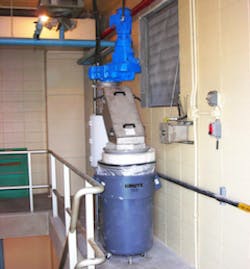Slimming Down, Shaping Up
The Oostburg Wastewater Treatment Plant (WWTP) in Oostburg, Wis., found the Huber’s Rotamat RoK4 vertical fine screen when seeking out a new head works screening solution. The facility’s engineers had doubted that a solution existed that could meet their requirements and limitations.
Oostburg’s facility is a lean operation with limitations in space for screening technology and in staff resources available to manage, maintain and report on the village’s processes. Because of these limitations and needs, the new fine screen solution needed to improve screening potential, reduce operational costs, operate in confined space and eliminate hands-on management.
Challenge
Even though space was limited, Oostburg’s operators knew that putting a head works screening solution in place would improve the facility’s operational efficiency. The operators also wanted to upgrade the WWTP’s technology from the aging and costly chopper-style comminutor in use at the time.
Solution
Oostburg maximizes the RoK4’s design because it requires the system to operate in a completely vertical motion as it pulls solids from the head works wet well. The RoK4 was installed with the system’s screen basket in the area that the comminutor occupied. This design required that the system raise the screenings vertically to the floor above for disposal. During the process upward, the screenings are washed, transported, dewatered, compacted and deposited into a continuous bagging unit. This all takes place in one square meter of floor space. Since the RoK4’s presence eliminates the need to chop solids, the comminutor is not missed.
The facility’s operations are managed and maintained by one man. But because of Huber’s RoK4 vertical screen, Plant Operator Greg Lemahieu has regained valuable time beyond his required maintenance, lab work and environmental reporting activities, allowing him to develop new ways to leverage the plant’s technologies and optimize operations.
Results
The scale of improvements that the RoK4 provides to their operations surprised the WWTP team. Immediately, they noticed that the solution works day after day as it pulls rags out in a vertical motion at the head works, eliminates downstream maintenance headaches that rag clogs can cause and minimizes the odors and noises of the previous comminutor grinder process.
Four factors illustrate the RoK4’s clean machine image.
1. The channel is cleaner from the onset. It gets the solid gunk out before it has the opportunity to start downstream.
2. It is low-odor by design. Any odors that result from screenings are concealed by the closed basket design.
3. Even the organics get “laundered”. It backwashes organics into the system for treatment.
4. It is a hands-off process. It washes, dewaters and compacts solids in a single step and then sends them directly to barrels through a continuous bagging process.
The RoK4 is made completely of stainless steel. There is no corrosion, even in the highly corrosive wet well environment. Oostburg’s RoK4 has required minimal repair or parts replacement, with only one set of auger brushes replaced over its six-year lifetime.
The RoK4 provides improvements in a facility’s maintenance and repair resources, both human and budgetary. Man-hours do not have to be committed to its operation, a repair budget is unnecessary and its maintenance schedule is minimal. Downtime associated with the RoK4 is practically nonexistent. The removal of solids in the head works reduces the workload for downstream components to such an extent that the period between rebuilds on downstream components such as pumps and clarifiers are extended. This is bottom-line reality for Oostburg, since rebuilds can cost as much as $5,000 per component per rebuild.
